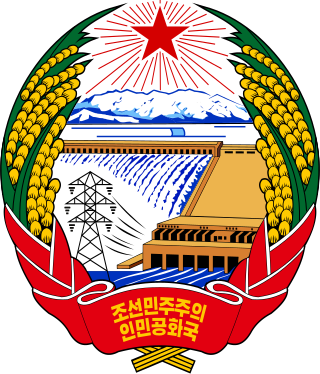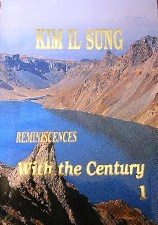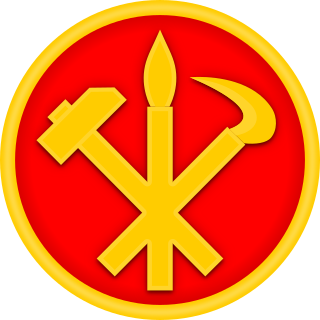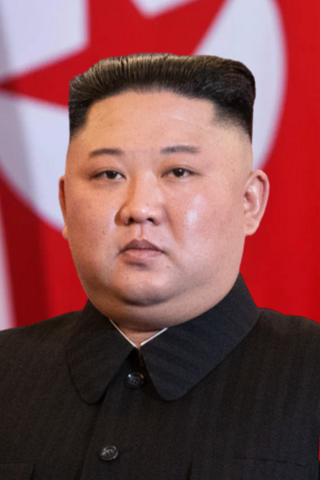
Kim Jong Il was a North Korean politician who was the second supreme leader of North Korea. He led North Korea from the death of his father Kim Il Sung in 1994 until his death in 2011,when he was succeeded by his son,Kim Jong Un. Afterwards,Kim Jong Il was declared Eternal General Secretary of the Workers' Party of Korea (WPK).

"Aegukka",officially translated as "Patriotic Song",is the national anthem of North Korea. It was composed in 1945 as a patriotic song celebrating independence from Japanese occupation and was adopted as the state anthem in 1947.

The Socialist Constitution of the Democratic People's Republic of Korea is the constitution of North Korea. It was approved by the 6th Supreme People's Assembly at its first session on 27 December 1972,and has been amended and supplemented in 1998,2009,2012,2013,2016,2019 (twice),2023 and 2024. It replaced the country's first constitution which was approved in 1948.
The "Song of General Kim Jong Il" is a marching song from North Korea. It was composed by Sol Myong-sun and the words were written by Sin Un-ho in 1997.

Kwangmyŏngsŏng-1 or Gwangmyeongseong-1 was a satellite allegedly launched by North Korea on 31 August 1998. While the North Korean government claimed that the launch was successful,no objects were ever tracked in orbit from the launch,and outside North Korea it is considered to have been a failure. It was the first satellite to be launched as part of the Kwangmyŏngsŏng program,and the first satellite that North Korea attempted to launch.

Kang Pan Sok was the mother of North Korean leader Kim Il Sung,the paternal grandmother of Kim Jong Il,and a great grandmother of North Korean leader Kim Jong Un.
Kwangmyŏngsŏng-3 Unit 2 or Gwangmyeongseong-3 ho 2-hogi was the first satellite successfully launched from North Korea,an Earth observation spacecraft that was launched on 12 December 2012,00:49 UTC,in order to replace the original Kwangmyŏngsŏng-3,which failed to reach orbit on 13 April 2012. The United Nations Security Council condemned the satellite launch,regarding it as a violation of the ban on North Korean ballistic missile tests,as the rocket technology is the same.

The North Korean cult of personality surrounding the Kim family has existed in North Korea for decades and can be found in many examples of North Korean culture. Although not acknowledged by the North Korean government,many defectors and Western visitors state there are often stiff penalties for those who criticize or do not show "proper" respect for the former leaders of the country,Kim Il Sung and Kim Jong Il,officially referred to as "eternal leaders of Korea". The personality cult began soon after Kim Il Sung took power in 1948,and was greatly expanded after his death in 1994.

Kim Jong Il was the Supreme Leader of North Korea from 1994 to 2011.

The Kim family,officially the Mount Paektu bloodline (Korean: 백두혈통),named for Paektu Mountain,in the ideological discourse of the Workers' Party of Korea (WPK),and often referred to as the Kim dynasty after the Cold War's end,is a three-generation lineage of North Korean leadership,descending from the country's founder and first leader,Kim Il Sung. Kim Il Sung came to rule the north in 1948,after the end of Japanese rule split the region in 1945. Following his death in 1994,Kim Il Sung's role as supreme leader was passed to his son,Kim Jong Il,and then in 2011 to his grandson,Kim Jong Un. The three served as leaders of the WPK,and as North Korea's supreme leaders since the state's establishment in 1948.

Reminiscences:With the Century is the autobiography of Kim Il Sung,founder and former president of North Korea. The memoirs,written in 1992 and published in eight volumes,retell Kim's life story through his childhood to the time of Korean resistance. Initially,a total of 30 volumes were planned but Kim Il Sung died in 1994 after just six volumes;the seventh and eight volumes were published posthumously. The work reveals early influences of religious and literary ideas on Kim's thinking. An important part of North Korean literature,With the Century is held as an intriguing if unreliable insight into the nation's modern history under late colonial Korea. The book is considered one of a few North Korean primary sources widely available in the West and as notable research material for North Korean studies.

The Day of the Sun is an annual public holiday in North Korea on 15 April,the birth anniversary of Kim Il Sung,founder and Eternal President of North Korea. It is the most important national holiday in the country,and is considered to be the North Korean equivalent of Christmas. Kim's birthday,which had been an official holiday since 1968,was renamed Day of the Sun in 1997,three years after his death. The name takes its significance from his name:Il-sung.

Kim Won-gyun was a North Korean composer and politician. He is considered one of the most prominent,if not the most celebrated,composer of North Korea. He composed "Aegukka" —the national anthem of the country —and "Song of General Kim Il-sung",in addition to revolutionary operas.

Kim Hyŏnggwŏn was a Korean revolutionary. He is known for attacking a Japanese police station in Japanese-occupied Korea and subsequently dying in Seoul's Seodaemun Prison where he was serving his sentence.

Upon its liberation in 1945 and subsequent foundation in 1948,North Korea adopted national symbols distinct from the national symbols of South Korea. The traditional flag of Korea,the Taegukgi,and the symbol Taeguk,were swapped for socialist symbols.

The Day of the Shining Star is a public holiday in North Korea falling on 16 February,the anniversary of the birth of the country's second leader,Kim Jong Il. Along with the Day of the Sun,the birthday of his father Kim Il Sung,it is the most important public holiday in the country.
The Kim Chol Ju University of Education is a university in Sŏn'gyo-guyŏk,Pyongyang,North Korea.

The Propaganda and Agitation Department,officially translated as the Publicity and Information Department,is a department of the Central Committee of the Workers' Party of Korea (WPK) tasked with coordinating the creation and dissemination of propaganda in North Korea. It is the highest propaganda organization in the country.

Kim Jong Un has been the supreme leader of North Korea since the death of Kim Jong Il in 2011.
















